Reactor 3 学习笔记(1)
Reactor 3 与之前学习的RxJava是同一类(反应式编程)框架,基本概念大致差不多,简单记录一下:
Reactor 3 利用了java 8中的CompletableFuture、Stream、Duration,在此基础上发展出了二个更通用的模型:Flux及Mono.
一、Flux
Flux 简单点讲,就是一个可以发射1到N个元素的异步"发射器",官方给的示例图如下:
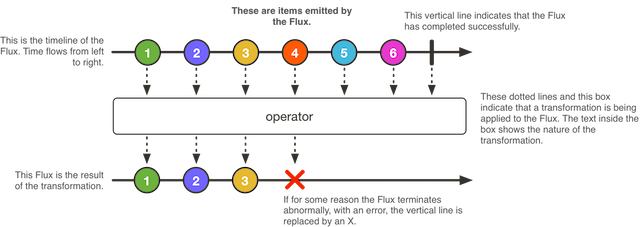
1,2,3...这些颜色各异的小圆,代表正常发射出来的数据;(对应onNext方法)
上右黑色的竖线表示发送完成;(对应onComplete方法)
如果发射过程中出现异常,竖线用大红叉叉表示;(对应onError方法)
二、Mono
相对Flux而言,Mono最多只能发射1个元素,示例图如下:

三、Gradle依赖
apply plugin: 'java'apply plugin: 'idea'repositories { maven { url "http://maven.aliyun.com/nexus/content/groups/public/" } mavenCentral() jcenter()}dependencies { compile 'io.projectreactor:reactor-core:3.1.6.RELEASE' testCompile('io.projectreactor:reactor-test:3.1.6.RELEASE') testCompile('junit:junit:4.8.2')} |
四、常用方法
4.1 、just/fromArray/range
1 2 3 4 5 6 7 8 9 10 | import org.junit.Test;import reactor.core.publisher.Flux;public class FluxTest { @Test public void fluxJustTest() { Flux.just("1", "A", 3).subscribe(System.out::println); }} |
点击just可以看到源码:
1 2 3 4 5 6 7 8 9 10 11 12 13 14 | /** * Create a {@link Flux} that emits the provided elements and then completes. * <p> * <img class="marble" src="https://raw.githubusercontent.com/reactor/reactor-core/v3.1.3.RELEASE/src/docs/marble/justn.png" alt=""> * <p> * @param data the elements to emit, as a vararg * @param <T> the emitted data type * * @return a new {@link Flux} */@SafeVarargspublic static <T> Flux<T> just(T... data) { return fromArray(data);} |
注意:注释中给了一个图片地址 https://raw.githubusercontent.com/reactor/reactor-core/v3.1.3.RELEASE/src/docs/marble/justn.png
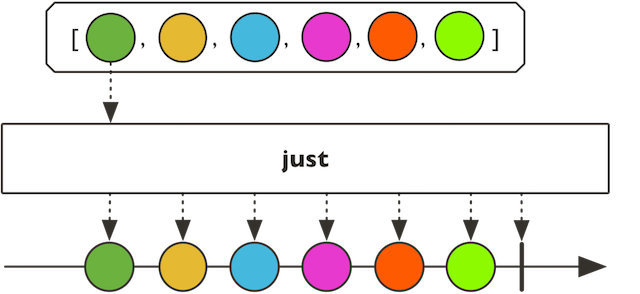
从图上看,就是发射一串数据。最终的输出也是如此:
1A3 |
其它类似的方法还有:fromArray、fromIterable、range 大家可以自行尝试。
4.2、interval
1 2 3 4 5 6 7 8 | @Testpublic void fluxIntervalTest() throws InterruptedException { Flux.interval(Duration.of(500, ChronoUnit.MILLIS)).subscribe(System.out::println); //防止程序过早退出,放一个CountDownLatch拦住 CountDownLatch latch = new CountDownLatch(1); latch.await();} |
顾名思义就是每隔一定时间,发射一个数据(从0开始),上面的示例表示每隔500毫秒,从0开始递增,发射1个数字,输出如下:
1 2 3 4 5 | 0123... |
4.3、empty/never/error
1 2 3 4 | @Testpublic void fluxEmptyTest() { Flux.empty().subscribe(System.out::println);} |
empty方法几乎啥都不干,就发一个结束消息完事,示意图如下:

empty源码如下:
1 2 3 | public static <T> Flux<T> empty() { return FluxEmpty.instance();} |
与之接近的,还有never方法
1 2 3 | public static <T> Flux<T> never() { return FluxNever.instance();} |
二者区别在于:empty里面至少还有一个结束消息,而never则是真的啥都没有。
还有一个比较特别的方法:error,只包含一个错误消息

示例代码如下:
1 | Flux.error(new Exception("a wo,something is wrong!")).subscribe(System.out::println); |
4.4、 generate/create
前面的几个方法,开发者不用显式的调用complete,而generate则需要调用,否则序列就不会终止。
1 2 3 4 5 6 7 8 9 10 11 12 13 14 15 16 17 18 19 | @Testpublic void fluxGenerateTest() { Flux.generate(i -> { i.next("AAAAA"); //i.next("BBBBB");//注意generate中next只能调用1次 i.complete(); }).subscribe(System.out::println); final Random rnd = new Random(); Flux.generate(ArrayList::new, (list, item) -> { Integer value = rnd.nextInt(100); list.add(value); item.next(value); if (list.size() >= 10) { item.complete(); } return list; }).subscribe(System.out::println);} |
输出如下:
1 2 3 4 5 6 7 8 9 10 11 | AAAAA8580321990720374633 |
注:generate中next只能调1次,否则会报错 reactor.core.Exceptions$ErrorCallbackNotImplemented: java.lang.IllegalStateException: More than one call to onNext

create方法则没有next的调用次数限制,见下面的代码:
1 2 3 4 5 6 7 8 9 10 11 12 13 14 15 | @Testpublic void fluxCreateTest() { Flux.create(i -> { i.next("A"); i.next("B"); i.complete(); }).subscribe(System.out::println); final Random rnd = new Random(); Flux.create(item -> { for (int i = 0; i < 10; i++) { item.next(i); } }).subscribe(System.out::println);} |
4.5、buffer/bufferTimeout/window/windowTimeout
1 2 3 4 5 6 7 8 9 10 11 12 13 14 | @Testpublic void fluxBufferTest() throws InterruptedException { Flux.range(0, 10).buffer(3).subscribe(System.out::println); System.out.println("--------------"); Flux.interval(Duration.of(1, ChronoUnit.SECONDS)) .bufferTimeout(2, Duration.of(2, ChronoUnit.SECONDS)) .subscribe(System.out::println); //防止程序过早退出,放一个CountDownLatch拦住 CountDownLatch latch = new CountDownLatch(1); latch.await();} |
字面意思理解,buffer指flux产生的数据,先缓冲起来,等缓冲区满了以后,才真正发射,所以上面的代码,第1段的意思是,0-9这10个数字,每次缓存3个,等3个数攒齐后,才输出。
而另一个版本bufferTimeout则不是根据元素的个数来缓冲,而是根据时间,第2段代码的意思是:flux每隔1秒,产生1个递增数字,而缓冲区每2秒才算充满,相当于每凑足2个数字后,才输出。
1 2 3 4 5 6 7 8 | [0, 1, 2][3, 4, 5][6, 7, 8][9]--------------[0, 1][2, 3][4, 5] |
buffer示例图如下:
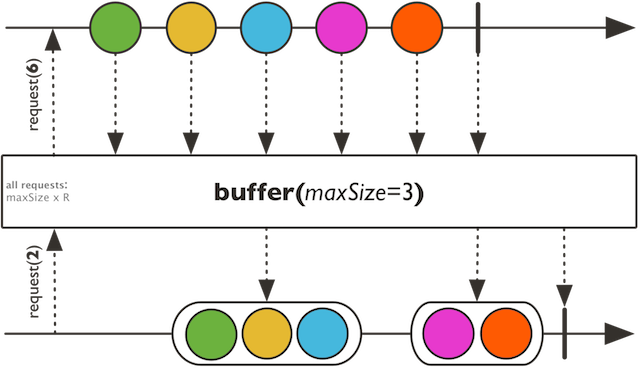
bufferTimeout示例图如下:
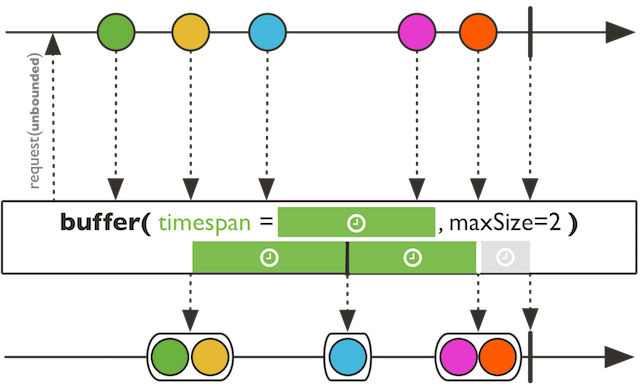
另外还有二个接近的方法window/windowTimeout,只是window/windowTimeout调用后的结果是Flux<Flux<T>>,处理过程中产生的流为UnicastProcessor对象。
window示意图:
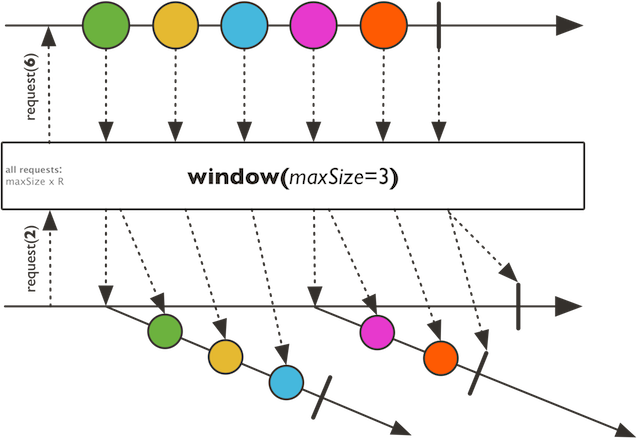
windowTimeout示意图:

4.6、filter
1 2 3 4 | @Testpublic void fluxFilterTest() { Flux.range(0, 10).filter(c -> c % 2 == 0).subscribe(System.out::println);} |
输出:
1 2 3 4 5 | 02468 |
示意图:
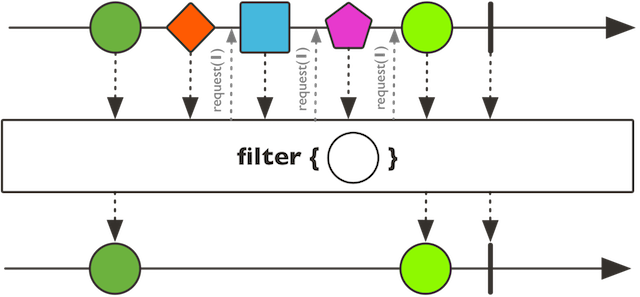
4.7 zipWith
1 2 3 4 | @Testpublic void fluxZipTest() { Flux.just("A", "B").zipWith(Flux.just("1", "2", "3")).subscribe(System.out::println);} |
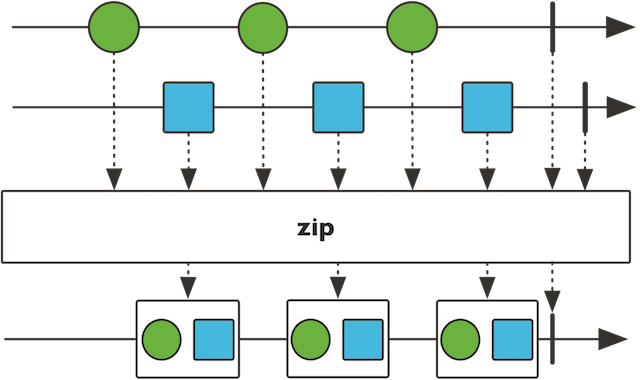
就是把各组元素,按位组合(就算用拉链袋封起来一样,因此得名),注意:这里有一个木桶原则,即 元素最少的"组",决定了最后输出的"组"个数。
上面代码的输出为:
1 2 | [A,1][B,2] |
4.8 take/takeLast/takeWhile/takeUntil
1 2 3 4 5 6 7 8 9 10 11 12 | @Testpublic void fluxTakeTest() { Flux.range(1, 10).take(3).subscribe(System.out::println); System.out.println("--------------"); Flux.range(1, 10).takeLast(3).subscribe(System.out::println); System.out.println("--------------"); Flux.range(1, 10).takeWhile(c -> c > 1 && c < 5).subscribe(System.out::println); System.out.println("--------------"); Flux.range(1, 10).takeUntil(c -> c > 1 && c < 5).subscribe(System.out::println); System.out.println("--------------"); Flux.range(1, 4).takeUntilOther(Flux.never()).subscribe(System.out::println);} |
take与takeLast很好理解,就是前n个或后n个。 takeWhile与takeUntil 需要记忆一下:
takeWhile 是先判断条件是否成立,然后再决定是否取元素(换言之,如果一开始条件不成立,就直接终止了);
takeUntil 是先取元素,直到遇到条件成立,才停下
takeUntilOther 则是先取元素,直到别一个Flux序列产生元素
所以上面的输出为:
1 2 3 4 5 6 7 8 9 10 11 12 13 14 15 16 | 123--------------8910----------------------------12--------------1234 |
注意:takeWhile无输出,因为判断条件一开始就不成立,直接cancel了;而takeUntilOther由于另一个flux使用了never()相当于没有任何元素,所以把前1个序列的元素取完,自然结束。
takeWhile的示意图如下:
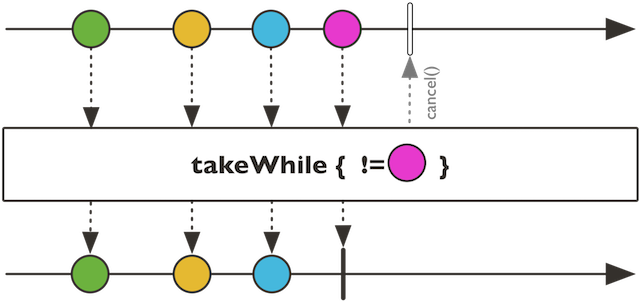
takeUntil的示意图如下:
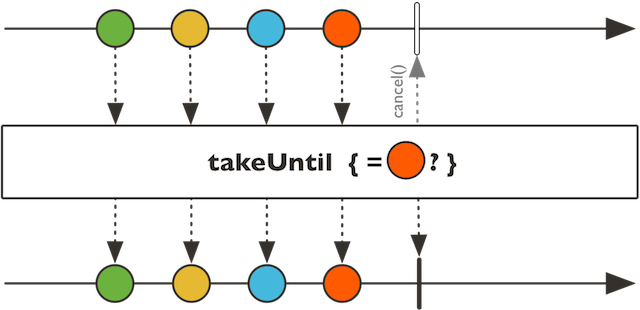
takeUntilOther的示意图如下:
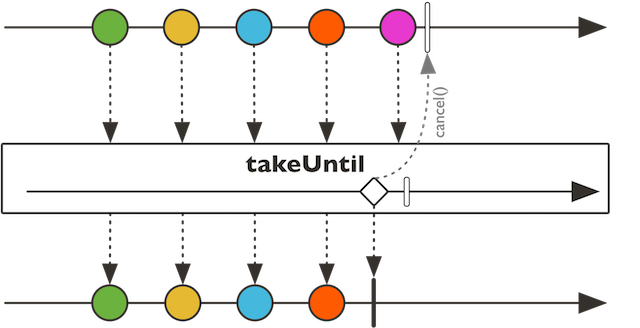
reactor的东西比较多,剩下的写到下篇吧
参考文章:
出处:http://yjmyzz.cnblogs.com
本文版权归作者和博客园共有,欢迎转载,但未经作者同意必须保留此段声明,且在文章页面明显位置给出原文连接,否则保留追究法律责任的权利。






【推荐】国内首个AI IDE,深度理解中文开发场景,立即下载体验Trae
【推荐】编程新体验,更懂你的AI,立即体验豆包MarsCode编程助手
【推荐】抖音旗下AI助手豆包,你的智能百科全书,全免费不限次数
【推荐】轻量又高性能的 SSH 工具 IShell:AI 加持,快人一步
· 10年+ .NET Coder 心语,封装的思维:从隐藏、稳定开始理解其本质意义
· .NET Core 中如何实现缓存的预热?
· 从 HTTP 原因短语缺失研究 HTTP/2 和 HTTP/3 的设计差异
· AI与.NET技术实操系列:向量存储与相似性搜索在 .NET 中的实现
· 基于Microsoft.Extensions.AI核心库实现RAG应用
· 10年+ .NET Coder 心语 ── 封装的思维:从隐藏、稳定开始理解其本质意义
· 地球OL攻略 —— 某应届生求职总结
· 提示词工程——AI应用必不可少的技术
· 字符编码:从基础到乱码解决
· Open-Sora 2.0 重磅开源!
2014-08-12 ehcache2.8.3入门示例:hello world